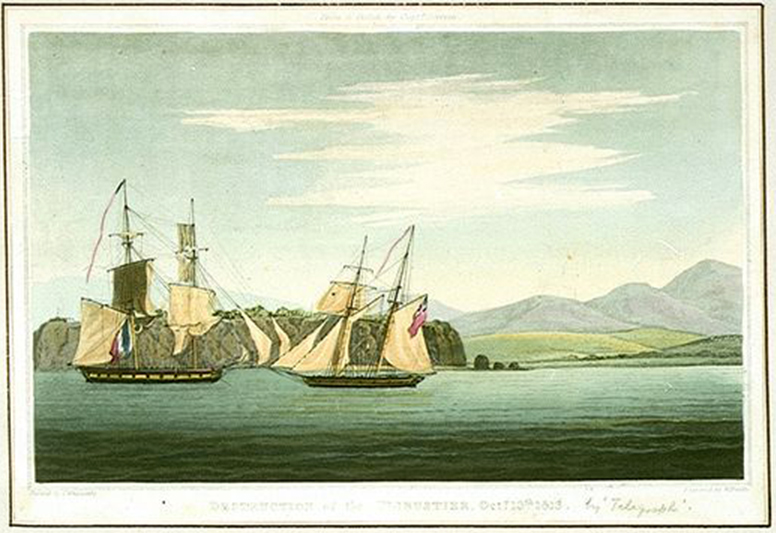HMS Telegraph
The 12 gun schooner Telegraph was built in New York in 1812 as the letter-of-marque Vengeance, one of two schooners captured by the frigate Phoebe (36) on New Year's Day in 1813. At the time the Vengeance was bound for Bordeaux, laden with cotton, sugar, indigo and coffee. Sent home with a prize crew, Vengeance arrived in Plymouth on 8 January and was taken in to Royal navy service as the Telegraph.
August 1817 found the Telegraph schooner on anti-smuggling duty where she captured the smuggling vessel Betsey along with her cargo of spirits. The Collector of His Majesty's Excise in Falmouth also paid bounty money for the three men who were on Betsey when the Telegraph brought her in.
The Vengeance was similar in design to the schooner HMS Whiting built in Baltimore in 1812 as the Arrow. Lt. Little was at one time the commander of Whiting while she was on the American station. The Whiting was wrecked on the Doom Bar off Padstow in 1816, see The Search for HMS Whiting.
In 1816 the Telegraph was under the command of Lt. John Little. On 20th January 1817 the Telegraph was at anchor in clear ground in Plymouth Sound when a violent storm struck; it appeared at first that the little schooner would ride out the gale in the shelter of the western end of the new but partially built Plymouth Breakwater.
The Plymouth breakwater was far from complete when it was tested by this extremely high tide and a storm of extraordinary violence blowing from the south creating waves 2m higher than a usual high spring tide.
By 4am the storm had not abated and the Telegraph had begun to drag, a third anchor was let go in an attempt to bring her up but without success. The Telegraph drove across the Sound, burning blue signal lights and firing distress guns, but in such a storm no-one could come to her aid. At 5:30am she struck the ground within a cables length of the shore by the eastern end of the Hoe. Fearing that the lightly build ship would soon be smashed to pieces, Lt. Little ordered the anchor cables cut and her fore staysail set so that she would lie sideways with her beam on to the shore. In this position the crew managed to scramble ashore before she quickly broke up. Only one man was lost in the incident, William Kells, who was crushed under the vessel when attempting to get on shore. Lt. Little did not quit his post until he had seen every officer, man and woman out of her.
I am grieved to find, H.M. Schooner Telegraph is completely
wrecked under the Hoe; but by a most wonderful interference
of Providence, only one man is lost.
Liverpool Mercury 24th January 1817
According to one newspaper account the ship's surgeon had both his thighs broken while rescuing his wife and several members of the crew were also treated for broken bones at the Naval Hospital in Plymouth.
After the storm had passed the shore was strewn with bodies and debris, the low-lying parts of Plymouth were flooded, a breach was made in the wall of the dockyard, the new road along the Hoe was destroyed and several houses in Cawsand had been demolished. The Breakwater suffered severe damage and 20 ton pavement stones were carried out to sea. Part of the upper layer of the breakwayer 200m long and 30m wide had been displaced, with stones from between two and five tons thrown right over the breakwater and on to its northern side.
The Court Martial was held for the incident aboard HMS Superb alongside the crew of HMS Jasper lost the swame night. Although the court was of the opinion that there is 'insufficiency in the length of the (anchor) cables' and 'weight of some of her anchors', it was deemed that Lt. Little, his officers and crew were not culpable. The court actually praised Lt. Little for his 'coolness and judgement' through which the lives of his crew were saved. The infamous frigate captain Sir Thomas Cochrane spoke very highly of the former services and good conduct of Mr. Little, when he was under his command.
The Telegraph was lost in the same storm as the Royal Navy brig sloop HMS Jasper and the packet Princess Mary.
![]() If you have any more information about this ship then please contact us.
If you have any more information about this ship then please contact us.
 HMS Telegraph caused the destruction of the French 16-gun brig Flibustier |
